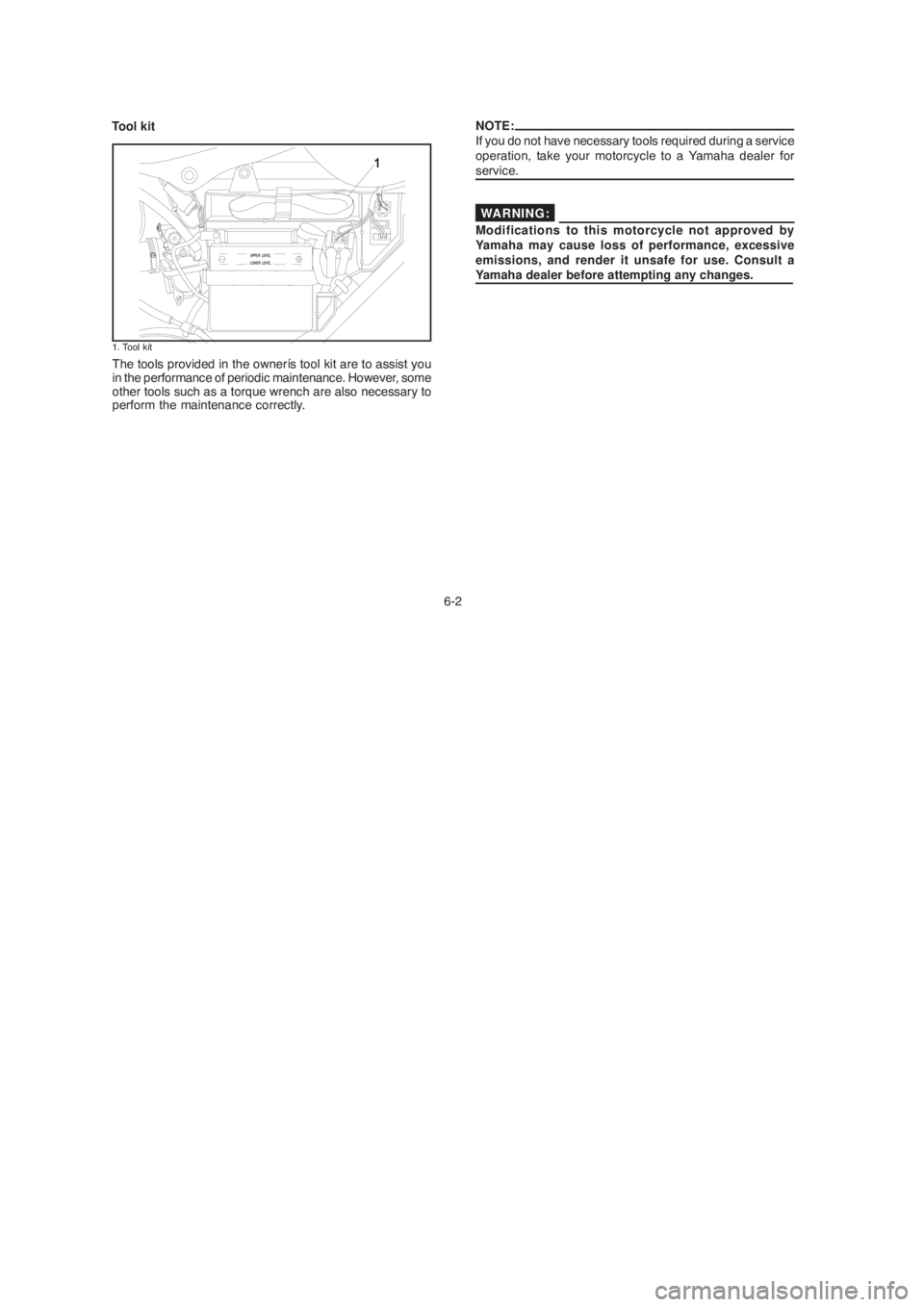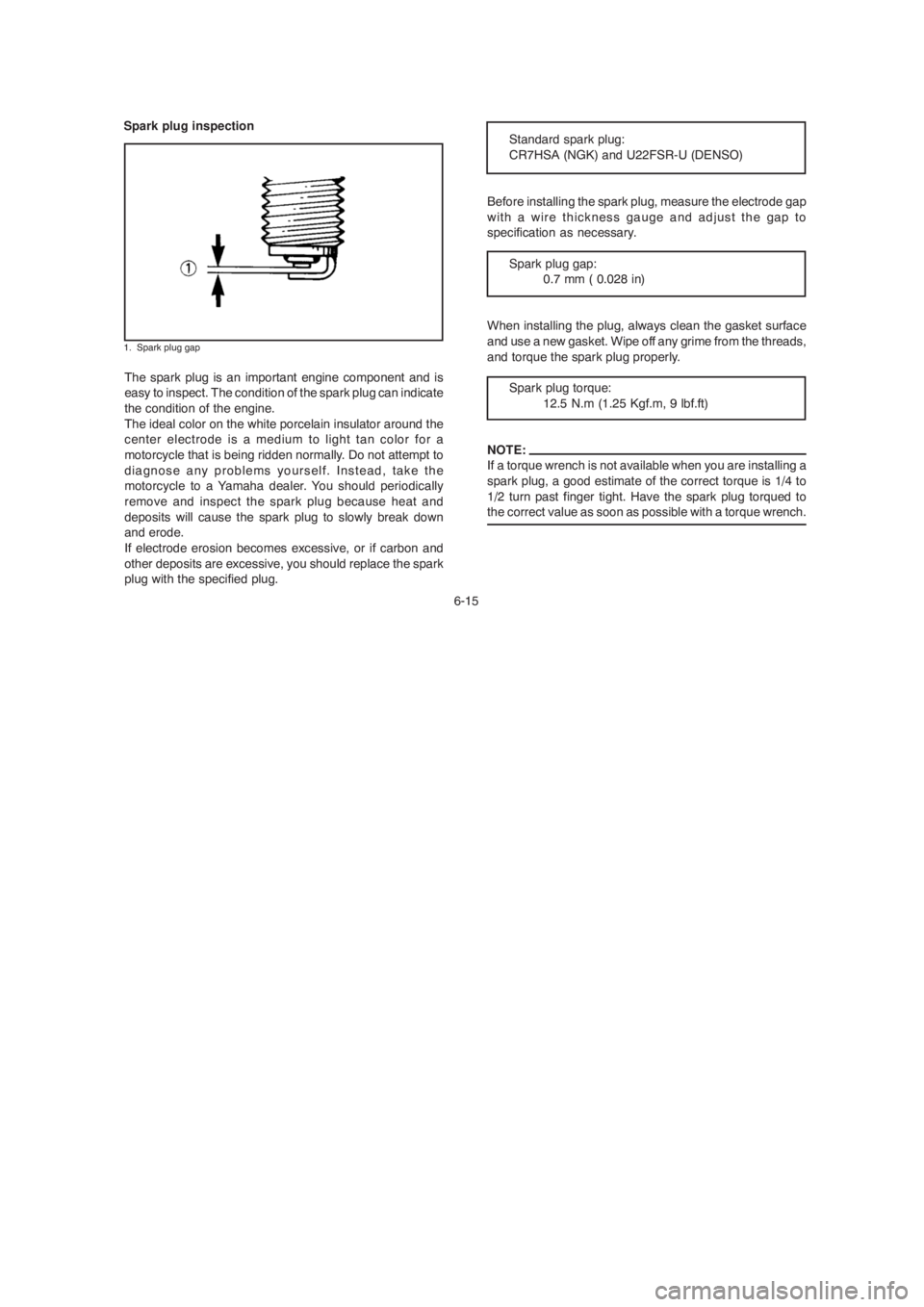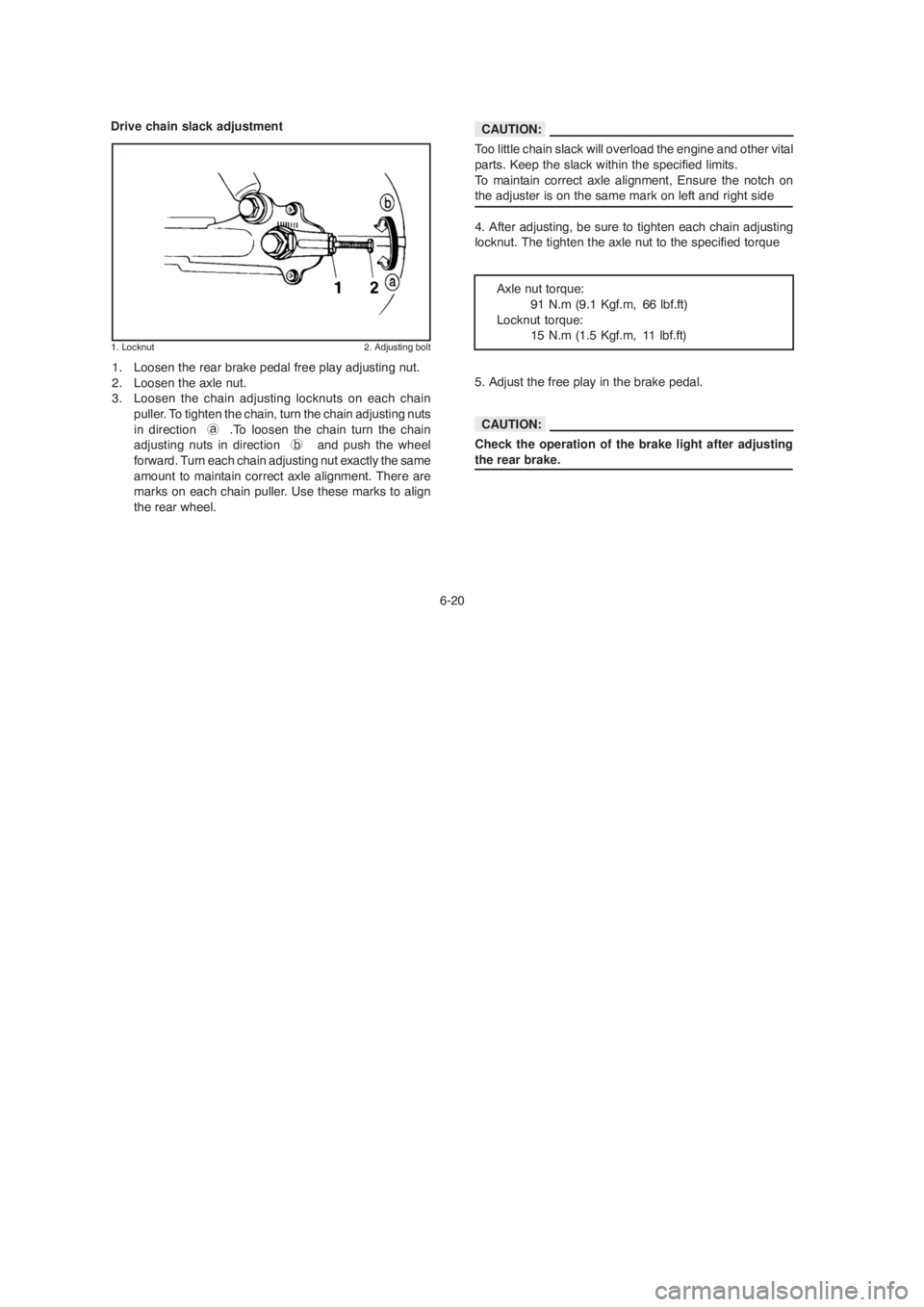2004 YAMAHA YBR125 torque
[x] Cancel search: torquePage 12 of 83

PERIODIC MAINTENANCE AND MINOR REPAIRS..... 6-1
Tool kit..................................................................... 6-2
PERIODIC MAINTENANCE/LUBRICATION......... 6-3
Torque specifications............................................. 6-5
Engine oil................................................................ 6-6
Oil pressure............................................................ 6-9
Air filter.................................................................6-10
Carburetor adjustment.........................................6-12
Valve clearance adjustment.................................6-12
Idle speed adjustment..........................................6-13
Throttle cable adjustment....................................6-14
Spark plug inspection...........................................6-15
Front brake adjustment........................................6-16
Checking the brake shoes ...................................6-16
Rear brake adjustment.........................................6-17
Brake light switch adjustment ..............................6-18
Clutch adjustment................................................ 6-18
Drive chain slack check.......................................6-19
Drive chain slack adjustment...............................6-20
Drive chain lubrication..........................................6-21
Cable inspection and lubrication.......................... 6-21
Throttle cable and grip lubrication .......................6-22
Brake and shift pedals .........................................6-22
Brake and clutch levers .......................................6-22
Sidestand.............................................................6-22
Front fork inspection............................................6-23Steering inspection.............................................. 6-24
Wheel bearings.................................................... 6-24
Battery.................................................................. 6-25
Replenishing the battery fluid .............................. 6-26
Storage the battery.............................................. 6-27
Fuse replacement................................................ 6-27
Headlight bulb replacement................................. 6-28
Turn signal bulb replacement.............................. 6-30
Taillight bulb replacement.................................... 6-30
Front wheel removal............................................. 6-31
Front wheel installation........................................ 6-32
Rear wheel removal............................................. 6-32
Rear wheel installation......................................... 6-33
Troubleshooting.................................................... 6-34
Troubleshooting chart.......................................... 6-35
CLEANING AND STORAGE....................................... 7-1
CLEANING............................................................. 7-1
STORAGE.............................................................. 7-2
SPECIFICATIONS ........................................................ 8-1
XII
CONTENTS
DESCRIPTION............................................................. 1-1
MACHINE IDENTIFICATION....................................... 2-1
Vehicle identikfication number ............................... 2-1
Engine serial number............................................ 2-1
CONTROL FUNCTIONS.............................................. 3-1
Main switch ............................................................ 3-1
Indicator lights ........................................................ 3-2
Speedometer..........................................................3-3
Fuel gauge............................................................. 3-3
Handlebar switches over left .................................. 3-4
Handlebar switches over right.............................. 3-5
Clutch lever............................................................ 3-6
Shift pedal............................................................. 3-6
Front brake lever................................................... 3-7
Rear brake pedal................................................... 3-7
Fuel tank cap......................................................... 3-8
Fuel cock............................................................... 3-9
Starter lever......................................................... 3-10
Kick starter .......................................................... 3-10
Steering lock....................................................... 3-11
Seat......................................................................3-12
Side covers......................................................... 3-13
Rear shock absorber adjustment ....................... 3-14
XIPRE-OPERATION CHECKS........................................ 4-1
Engine oil................................................................ 4-3
Tires........................................................................4-3
Fitting/Fasteners....................................................4-6
Switches................................................................ 4-6
Wheels ......................................................... 4-6
Fuel ........................................................... 4-7
OPERATION AND IMPORTANT RIDING POINTS....... 5-1
Starting a cold engine........................................... 5-2
Starting a warm engine .......................................... 5-2
Warming up the engine .......................................... 5-2
Shifting ................................................................... 5-3
Tips for reduccing fuel consumption...................... 5-4
Engine Break-in...................................................... 5-4
Parking ................................................................... 5-5
Page 34 of 83

4-6
1. It is dangerous to ride with a worn-out tire. When
the tire tread begin to show signs of wear, replace
the tire immediately. Brakes, tires and related wheel
parts should be left to a Yamaha dealer.
2. Patching a punctured tube is not recommended. If
it is absolutely necessary to do so, use great care
and replace the tube as soon as possible with a
good quality replacement.
Fitting/Fasteners
Alway check the tightness of chassis fittings and fasteners
before a ride. Use the chart on page 6-5 to find the correct
torque.
Switches
Check the operation of the starter switch, main switch,
ì Engine Stopî switch.
WARNING:Wheels
To ensure maximum performance, long service, and safe
operation, note the following:
1. Always inspect the wheels before a ride. Check for
cracks, bends, or warpage of the wheel; be sure the
spokes are tight and undamaged. If any abnormal
condition exists in a wheel, consult a Yamaha dealer or
other qualified mechanic. Do not attempt even small
repairs to the wheel. If a wheel is deformed or cracked,
it must be replaced.
2. Tires and wheels should be balanced whenever either
one is changed or replaced. Failure to have a wheel
balanced can result in poor performance, adverse
handling characteristics, and shortened tire life.
3. After installing a tire, ride conservatively to allow the
tire to seat itself on the rim properly. Failure to allow
proper seating may cause tire failure, resulting in
damage to the motorcycle and injury to the rider.
4-6
1. It is dangerous to ride with a worn-out tire. When
the tire tread begin to show signs of wear, replace
the tire immediately. Brakes, tires and related wheel
parts should be left to a Yamaha dealer.
2. Patching a punctured tube is not recommended. If
it is absolutely necessary to do so, use great care
and replace the tube as soon as possible with a
good quality replacement.
Fitting/Fasteners
Alway check the tightness of chassis fittings and fasteners
before a ride. Use the chart on page 6-5 to find the correct
torque.
Switches
Check the operation of the starter switch, main switch,
ì Engine Stopî switch.
WARNING:Wheels
To ensure maximum performance, long service, and safe
operation, note the following:
1. Always inspect the wheels before a ride. Check for
cracks, bends, or warpage of the wheel; be sure the
spokes are tight and undamaged. If any abnormal
condition exists in a wheel, consult a Yamaha dealer or
other qualified mechanic. Do not attempt even small
repairs to the wheel. If a wheel is deformed or cracked,
it must be replaced.
2. Tires and wheels should be balanced whenever either
one is changed or replaced. Failure to have a wheel
balanced can result in poor performance, adverse
handling characteristics, and shortened tire life.
3. After installing a tire, ride conservatively to allow the
tire to seat itself on the rim properly. Failure to allow
proper seating may cause tire failure, resulting in
damage to the motorcycle and injury to the rider.
Page 42 of 83

NOTE:
If you do not have necessary tools required during a service
operation, take your motorcycle to a Yamaha dealer for
service.
Modifications to this motorcycle not approved by
Yamaha may cause loss of performance, excessive
emissions, and render it unsafe for use. Consult a
Yamaha dealer before attempting any changes.
6-2 Tool kit
The tools provided in the ownerís tool kit are to assist you
in the performance of periodic maintenance. However, some
other tools such as a torque wrench are also necessary to
perform the maintenance correctly.
1. Tool kit
WARNING:
NOTE:
If you do not have necessary tools required during a service
operation, take your motorcycle to a Yamaha dealer for
service.
Modifications to this motorcycle not approved by
Yamaha may cause loss of performance, excessive
emissions, and render it unsafe for use. Consult a
Yamaha dealer before attempting any changes.
6-2 Tool kit
The tools provided in the ownerís tool kit are to assist you
in the performance of periodic maintenance. However, some
other tools such as a torque wrench are also necessary to
perform the maintenance correctly.
1. Tool kit
WARNING:
Page 45 of 83

Torque specifications
Use a torque wrench to tighten these items. It is
recommended that these items be checked occasionally,
specially before a long trip. Always check the tightness of
these items whenever they are loosened for any reason.
6-5
Torque
Nm
kgf.m Item
Spark plug
Engine oil drain plug
Oil check bolt
Front wheel axle nut
Rear wheel axle nut
12,5
20
7
45
911,25
2,0
0,7
4,5
9,1
A
(Nut)
10 mm
12 mm
14 mm
17 mm
19 mm
22 mmB
(Bolt)
6 mm
8 mm
10 mm
12 mm
14 mm
16 mmGeneral torque especifications
Nm
6
15
30
55
85
130kgf.m
0,6
1,5
3,0
5,5
8,5
13,0lbf. ft
4,3
11
22
40
61
94
lbf.ft
9.0
14.5
5.0
32.5
66
Torque specifications
Use a torque wrench to tighten these items. It is
recommended that these items be checked occasionally,
specially before a long trip. Always check the tightness of
these items whenever they are loosened for any reason.
6-5
Torque
Nm
kgf.m Item
Spark plug
Engine oil drain plug
Oil check bolt
Front wheel axle nut
Rear wheel axle nut
12,5
20
7
45
911,25
2,0
0,7
4,5
9,1
A
(Nut)
10 mm
12 mm
14 mm
17 mm
19 mm
22 mmB
(Bolt)
6 mm
8 mm
10 mm
12 mm
14 mm
16 mmGeneral torque especifications
Nm
6
15
30
55
85
130kgf.m
0,6
1,5
3,0
5,5
8,5
13,0lbf. ft
4,3
11
22
40
61
94
lbf.ft
9.0
14.5
5.0
32.5
66
Page 47 of 83

6-7
2. Engine oil and filter replacement
a. Warm up the engine for a few minutes.
b. Stop the engine. Place an oil pan under the engine and
remove the dipstick.
c. Remove the drain plug and drain the oil.
d. Reinstall the drain plug, check if the gasket is damaged
and tighten it to the specified torque.
Tightening torque:
Drain plug:
20 N.m (2.0 kgf.m, 14.5 lbf.t)
1.Dipstick
1. Engine oil drain plug
6-7
2. Engine oil and filter replacement
a. Warm up the engine for a few minutes.
b. Stop the engine. Place an oil pan under the engine and
remove the dipstick.
c. Remove the drain plug and drain the oil.
d. Reinstall the drain plug, check if the gasket is damaged
and tighten it to the specified torque.
Tightening torque:
Drain plug:
20 N.m (2.0 kgf.m, 14.5 lbf.t)
1.Dipstick
1. Engine oil drain plug
Page 49 of 83

6-9 Oil pressure
1. Remove the check bolt 1 in the cylinder head.
2. Start the engine and keep it idling until oil flows out
of the bleed hole. If no oil comes out after one
minute, turn off the engine immediately so it will
not seize. In such a case go to the nearest Yamaha
dealer or other qualified mechanic for repairs.
3. After checking, tighten the check bolt to the
specified torque.
Check bolt torque:
7 N.m (0.7 Kgf.m, 5.0 lbf.ft)
1. Check bolt
6-9 Oil pressure
1. Remove the check bolt 1 in the cylinder head.
2. Start the engine and keep it idling until oil flows out
of the bleed hole. If no oil comes out after one
minute, turn off the engine immediately so it will
not seize. In such a case go to the nearest Yamaha
dealer or other qualified mechanic for repairs.
3. After checking, tighten the check bolt to the
specified torque.
Check bolt torque:
7 N.m (0.7 Kgf.m, 5.0 lbf.ft)
1. Check bolt
Page 55 of 83

6-15
1. Spark plug gap
Spark plug inspection
The spark plug is an important engine component and is
easy to inspect. The condition of the spark plug can indicate
the condition of the engine.
The ideal color on the white porcelain insulator around the
center electrode is a medium to light tan color for a
motorcycle that is being ridden normally. Do not attempt to
diagnose any problems yourself. Instead, take the
motorcycle to a Yamaha dealer. You should periodically
remove and inspect the spark plug because heat and
deposits will cause the spark plug to slowly break down
and erode.
If electrode erosion becomes excessive, or if carbon and
other deposits are excessive, you should replace the spark
plug with the specified plug.Standard spark plug:
CR7HSA (NGK) and U22FSR-U (DENSO)
Before installing the spark plug, measure the electrode gap
with a wire thickness gauge and adjust the gap to
specification as necessary.
Spark plug gap:
0.7 mm ( 0.028 in)
When installing the plug, always clean the gasket surface
and use a new gasket. Wipe off any grime from the threads,
and torque the spark plug properly.
Spark plug torque:
12.5 N.m (1.25 Kgf.m, 9 lbf.ft)
NOTE:
If a torque wrench is not available when you are installing a
spark plug, a good estimate of the correct torque is 1/4 to
1/2 turn past finger tight. Have the spark plug torqued to
the correct value as soon as possible with a torque wrench.
6-15
1. Spark plug gap
Spark plug inspection
The spark plug is an important engine component and is
easy to inspect. The condition of the spark plug can indicate
the condition of the engine.
The ideal color on the white porcelain insulator around the
center electrode is a medium to light tan color for a
motorcycle that is being ridden normally. Do not attempt to
diagnose any problems yourself. Instead, take the
motorcycle to a Yamaha dealer. You should periodically
remove and inspect the spark plug because heat and
deposits will cause the spark plug to slowly break down
and erode.
If electrode erosion becomes excessive, or if carbon and
other deposits are excessive, you should replace the spark
plug with the specified plug.Standard spark plug:
CR7HSA (NGK) and U22FSR-U (DENSO)
Before installing the spark plug, measure the electrode gap
with a wire thickness gauge and adjust the gap to
specification as necessary.
Spark plug gap:
0.7 mm ( 0.028 in)
When installing the plug, always clean the gasket surface
and use a new gasket. Wipe off any grime from the threads,
and torque the spark plug properly.
Spark plug torque:
12.5 N.m (1.25 Kgf.m, 9 lbf.ft)
NOTE:
If a torque wrench is not available when you are installing a
spark plug, a good estimate of the correct torque is 1/4 to
1/2 turn past finger tight. Have the spark plug torqued to
the correct value as soon as possible with a torque wrench.
Page 60 of 83

6-20
Drive chain slack adjustment
1. Locknut 2. Adjusting bolt
1. Loosen the rear brake pedal free play adjusting nut.
2. Loosen the axle nut.
3. Loosen the chain adjusting locknuts on each chain
puller. To tighten the chain, turn the chain adjusting nuts
in direction a .To loosen the chain turn the chain
adjusting nuts in direction b and push the wheel
forward. Turn each chain adjusting nut exactly the same
amount to maintain correct axle alignment. There are
marks on each chain puller. Use these marks to align
the rear wheel.Too little chain slack will overload the engine and other vital
parts. Keep the slack within the specified limits.
To maintain correct axle alignment, Ensure the notch on
the adjuster is on the same mark on left and right side
4. After adjusting, be sure to tighten each chain adjusting
locknut. The tighten the axle nut to the specified torque
Axle nut torque:
91 N.m (9.1 Kgf.m, 66 lbf.ft)
Locknut torque:
15 N.m (1.5 Kgf.m, 11 lbf.ft)
5. Adjust the free play in the brake pedal.
Check the operation of the brake light after adjusting
the rear brake.
CAUTION:
CAUTION:
6-20
Drive chain slack adjustment
1. Locknut 2. Adjusting bolt
1. Loosen the rear brake pedal free play adjusting nut.
2. Loosen the axle nut.
3. Loosen the chain adjusting locknuts on each chain
puller. To tighten the chain, turn the chain adjusting nuts
in direction a .To loosen the chain turn the chain
adjusting nuts in direction b and push the wheel
forward. Turn each chain adjusting nut exactly the same
amount to maintain correct axle alignment. There are
marks on each chain puller. Use these marks to align
the rear wheel.Too little chain slack will overload the engine and other vital
parts. Keep the slack within the specified limits.
To maintain correct axle alignment, Ensure the notch on
the adjuster is on the same mark on left and right side
4. After adjusting, be sure to tighten each chain adjusting
locknut. The tighten the axle nut to the specified torque
Axle nut torque:
91 N.m (9.1 Kgf.m, 66 lbf.ft)
Locknut torque:
15 N.m (1.5 Kgf.m, 11 lbf.ft)
5. Adjust the free play in the brake pedal.
Check the operation of the brake light after adjusting
the rear brake.
CAUTION:
CAUTION: